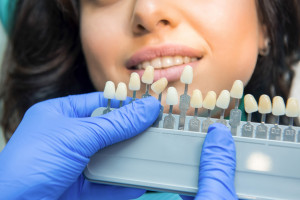There are several reasons for the discoloration of teeth, including a gray discoloration. Here’s a list of causes and what—if anything—you can do about it.
Genes
Dentinogenesis imperfecta is the fancy term, but all it means is that genetically you are predisposed to a less than pearly white set of teeth. For some people, their shade is yellowish-brown, for others it is blueish-gray. The issue lies within the enamel covering the structure of your teeth.
Hygiene
This is a cause of tooth discoloration that you do have some control over. However, tooth discoloration due to a lack of brushing and flossing will more commonly turn teeth yellowish-brown. In cases of pulp necrosis, there is a death of tooth cells. Sometimes it’s caused by bacteria, sometimes not. So, to up the odds of keeping teeth white, keep up the brushing and flossing and dental cleanings.
Drugs
Long-term studies have shown that exposure to tetracycline while in the womb can lead to discolored teeth, typical grayish and with striping. These are permanent stains, so good dental hygiene unfortunately can’t change it. Fortunately, your dentist does have other options for you, such as veneers or other cosmetic dentistry procedures.
Trauma
Teeth are not bones, per se, but they are part of your skeletal system. Why’s this matter? Because teeth are living, changing parts of your body. They are not dead cells. That means they can die. The pulp and nerves inside can die. The most common cause of this is trauma, which is why wearing a mouthguard during sports or at night if you grind your teeth is vital. Car accidents, falls, fights, and a myriad of other events can cause enough trauma to kill off a tooth or teeth. So, be careful out there.
What can be done
Just like with yellowish-brown teeth, gray teeth can be made whiter. Sometimes over-the-counter whitening toothpaste and other whitening products can improve tooth color, other times a dentist-strength process is needed.
It’s important to realize that sometimes gray teeth won’t respond as well to these treatments, especially in cases where tetracycline is the discoloration culprit. The result is often an uneven whitening. If this is your situation, don’t despair. Discuss veneers and other cosmetic options with your dentist. A new smile awaits.








Leave a Reply